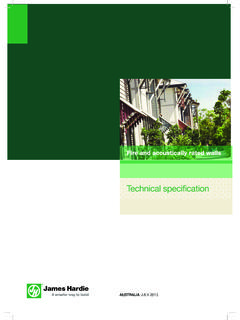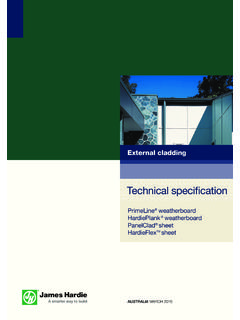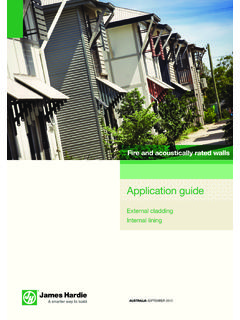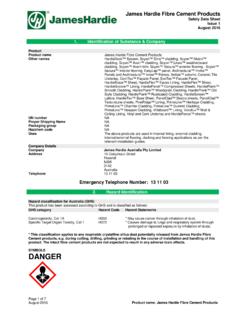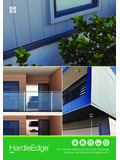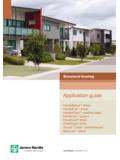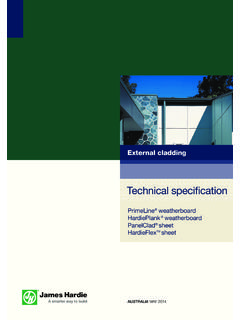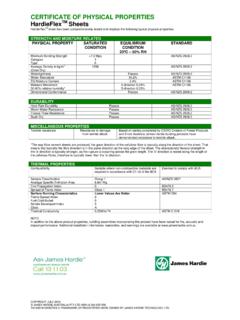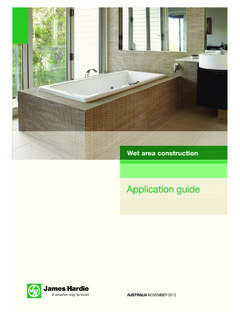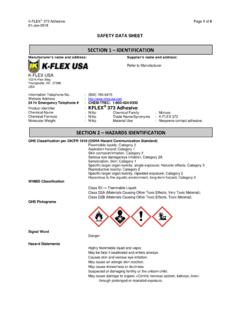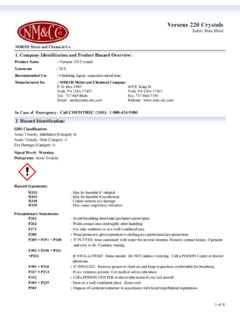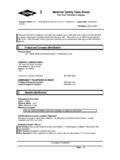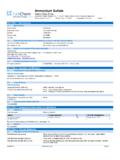Transcription of 2. Hazard Identification - James Hardie Industries
1 James Hardie Joint Sealant Safety Data Sheet Issue 1 November 2016 Page 1 of 7 November 2016 Product name: James Hardie Joint Sealant 1. Identification of Substance & Company Product Product name James Hardie Joint Sealant Product code Not assigned UN number NA Proper Shipping Name NA Packaging group NA Hazchem code NA Uses Joint Sealand Company Details Company James Hardie Research Pty Limited Address 10 Colquhoun Street Rosehill NSW 2142 Australia Telephone 13 11 03 Emergency Telephone Number: 13 11 03 (AU) and 0800 808 868 (NZ) 2. Hazard Identification Hazard classification for Australia (GHS) This product has been assessed according to GHS and is classified as follows: GHS category Hazard Code Hazard Statements Acute toxicity Inhalation Cat 4 H332 Harmful if inhaled. Respiratory sensitizer Cat 1 H334 May cause allergy or asthma symptoms or breathing difficulties if inhaled.
2 Skin Sensitiser Cat 1 H317 May cause an allergic skin reaction. SYMBOLS DANGER Other Classifications NOTE: Contains isocyanates. May produce an allergic reaction. Precautionary Statements Prevention P261 P271 P272 P280 P285 Response Avoid breathing vapours. Use only outdoors or in a well-ventilated area. Contaminated work clothing should not be allowed out of the workplace. Wear protective gloves. In case of inadequate ventilation wear respiratory protection. IF ON SKIN: Wash with plenty of soap and water. James Hardie Joint Sealant Safety Data Sheet Issue 1 November 2016 Page 2 of 7 November 2016 Product name: James Hardie Joint Sealant P302+P352 P333+P313 P363 P304+P340 P312 P341+P311 Storage none Disposal P501 If skin irritation or rash occurs: Get medical advice/attention. Wash contaminated clothing before reuse.
3 IF INHALED: Remove victim to fresh air and keep at rest in a position comfortable for breathing. Call a POISON CENTER or doctor/physician if you feel unwell. If experiencing respiratory symptoms: Call a POISON CENTER or doctor/ physician none Dispose of contents/container in accordance with local/regional/national/international regulations. 3. Composition / Information on Ingredients Component CAS/ Identification Concentration Toluene diisocyanate 584-84-9 <1% Ingredients determined not to be hazardous proprietary balance This is a commercial product whose exact ratio of components may vary. Trace quantities of impurities are also likely. 4. First Aid General Information If medical advice is needed, have product container or label at hand. You should call the Poisons Information Centre if you feel that you may have been harmed or irritated by this product.
4 The number is 13 11 26 (AU) and 0800 764 766 (NZ) (24 hr, 7 days a week emergency service). Recommended first aid facilities Ready access to running water is recommended. Exposure Swallowed Do NOT induce vomiting. Give a glass of water to drink. If any symptoms occur, contact a doctor. Eye contact If product gets in eyes, wash material from them with running water for several minutes. If symptoms persist, seek medical advice. Skin contact IF ON SKIN: Wash with plenty of soap and water. If skin irritation or rash occurs: Get medical advice/attention. Wash contaminated clothing before reuse. Inhaled IF INHALED: If breathing is difficult, remove to fresh air and keep at rest in a position comfortable for breathing. If experiencing respiratory symptoms: Call a POISON CENTRE or doctor/physician. Advice to Doctor Treat symptomatically 5.
5 Firefighting Measures Fire and explosion hazards : There are no specific risks for fire/explosion for this chemical. It is not classed as flammable, but is a combustible material. Suitable extinguishing substances: Not applicable. Unsuitable extinguishing substances: Not applicable. Products of combustion: Carbon dioxide, and if combustion is incomplete, carbon monoxide and smoke. Water. May form toxic mixtures in air and may accumulate in sumps, pits and other low-lying spaces, forming potentially explosive mixtures. Protective equipment: Self-contained breathing apparatus. Safety boots, non-flammable overalls, gloves, hat and eye protection. Hazchem code: 1T (recommended, no signage required) James Hardie Joint Sealant Safety Data Sheet Issue 1 November 2016 Page 3 of 7 November 2016 Product name: James Hardie Joint Sealant 6.
6 Accidental Release Measures Emergency procedures If a significant spill occurs: Stop the source of the leak, if safe to do so. Wear protective equipment to prevent skin, eye and respiratory exposure. Clear area of any unprotected personnel. Contain using sand, earth or vermiculite. Do not use sawdust. Prevent by whatever means possible any spillage from entering drains, sewers, or water courses. (If this occurs contact your regional council immediately). Clean-up method This product is not considered flammable or ecotoxic. Small spills do not require any special clean up method. Larger spills should be collected. Use absorbent (soil, sand or other inert material). Rags are not recommended for the clean-up of spills, as they may create fire or environmental Hazard . Collect and seal in properly labelled containers or drums for disposal.
7 If contamination of crops, sewers or waterways has occurred advise local emergency services. Do not wash material down stormwater drains. Disposal Mop up and collect recoverable material into labelled containers for recycling or salvage. Recycle containers wherever possible. This material may be suitable for approved landfill. Dispose of only in accord with all regulations. Precautions Slippery when spilt. Wear protective equipment to prevent eye and skin contamination and the inhalation of vapours. Work up wind or increase ventilation. 7. Storage & Handling Storage Avoid storage of harmful substances with food. Store out of reach of children. Containers should be kept closed in order to minimise contamination. Keep in a cool, dry place. Avoid contact with incompatible substances as listed in Section 10. Handling Keep exposure to a minimum, and minimise the quantities kept in work areas.
8 See section 8 with regard to personal protective equipment requirements. Avoid skin and eye contact and inhalation of vapour. 8. Exposure Controls / Personal Protective Equipment Exposure Standards An Exposure Standard (ES) for the mixture has not been established. Below are the exposure standards for the ingredients that are listed in the NOHSC: 1003. NOHSC (NOHSC:1003) Ingredient ES-TWA ES-STEL Isocyanates, all (as NCO) (Sen) Note: Sen sensitizer. This substance can cause a specific immune response in sensitized individuals. An affected individual may subsequently react to exposure to minute levels of that substance. Engineering Controls In industrial situations, concentration values below the ES value must be maintained. Exposure can be reduced by process modification, use of local exhaust ventilation, capturing substances at the source, or other methods.
9 If you believe airborne concentrations of mists, dusts or vapours are high, you are advised to modify processes or increase ventilation. James Hardie Joint Sealant Safety Data Sheet Issue 1 November 2016 Page 4 of 7 November 2016 Product name: James Hardie Joint Sealant Personal Protective Equipment Eyes Avoid contact with eyes. Use safety glasses or goggles if splashes are likely. Skin Avoid repeated or prolonged skin contact. Wear overalls, rubber boots and impervious gloves, PVAor Natural Rubber Gloves. Nitrile gloves are not recommendedfor Toluene diisocyanate. Remove protective clothing and wash exposed areas with soap and water prior to eating, drinking or smoking. Wash hands after handling. Respiratory A respirator when airborne concentrations approach the ES (section 8). Use a respirator with an organic vapour cartridge and particulate filter (dust/mist).
10 If using a respirator, ensure that the cartridges are correct for the potential air contamination and are in good working order. Fit testing and clear guidelines and training for use and maintenance of PPE are necessary. WES Additional Information No additional information 9. Physical & Chemical Properties Appearance liquid, various colours Odour aromatic pH no data Vapour pressure no data Viscosity not available Boiling point no data Volatile materials no data Freezing / melting point no data Solubility no data Specific gravity / density @ 20 C Flash point no data Danger of explosion not explosive Auto-ignition temperature no data Upper & lower flammable limits no data Corrosiveness non corrosive 10. Stability & Reactivity Stability Stable Conditions to be avoided Containers should be kept closed in order to avoid contamination.
